At CarnivoreWeb.com, we independently review products and outfitters. However, we may earn a commission when you purchase products through links on our site. Read our affiliate policy. Read about how we test products.
Selecting the ideal hunting pack means balancing size, weight, and features for your trip.
Like everything else in the world, backpacks are more specialized than ever. Hunting packs offer features tailored to the task like never before. Load shelves, spotting scope pockets, and gun bearing systems abound. But for all their whizbangery, fit is still the most important aspect of pack selection and use.
We’ll outline some key considerations of modern pack selection and fitting, and offer some tips that’ll get you and your new pack out into the backcountry ready to pack out with your sacred prize.
Choosing A Hunting Pack
Capacity
Choosing the right size pack requires some introspection. First, figure out how long you’re going to be in the field and what time of year you’re going to use your pack. Fair, stable weather means less gear, late season cool-to-cold climes require the ability to flex with your loadout — and that means more gear. Look deep into your soul … are you an overpacker? If so, consider getting the smaller of the packs you’re looking at so you don’t hate yourself the second hour of a five-mile pack-in. Otherwise, look at the next size up. Most modern packs are adorned with compression straps that’ll turn an 80-liter beast into a 40-liter day-and-a-half pack.
As a starting point, look at 30- to 45-liter packs as scouting or daypacks that’ll serve as an overnight pack in good weather with ultralight camp gear. Step up to 50 to 70 liters for five nights of good weather, three to five if it’s sketchy. Seventy- to 100-liter packs will give you room for a week of gear and provisions for a week of good weather, maybe four to seven days of a late season adventure. Ninety- to 110- liter packs are for 10-day sheep hunts, where the weather sucks and you want to pack in a basecamp’s worth of provisions and shelter.
Weight
Load carriage comes down to the hip belt and the frame. A soft-backed pack will just sag as it’s loaded, turning into a marshmallow. Frames give packs rigidity and support the load independently from your back. Starting at the belt, a belt with some structure is needed to keep the load stable and on your hips. The frame itself is ideally a three-dimensional structure that fits the broad topography of your back.
Pack designer Jeff Knight, one of the founders of Granite Gear and the father of ultralight packs, introduced the 3D pack sheet decades ago and likened this evolutionary step to a spoon on the nose. “If the pack frame conforms to the topography of the back, not just as an S-curve, but the roll of the shoulders and the spinal recess, it’s going to stay in place and provide a lot more stability and prevent sag.”
The progression of load carriage capability begins with frame stays that run up the back and provide good support for 50 to 60 pounds. Partially structured frames made from high-tenacity fabrics stretched between rigid perimeter poles carry more weight and weigh less than many fully structured frames that use a single sheet of polymer. Though fully structured frames offer the greatest load carriage ability and comfort at the cost of weight … generally. These are broad rules and things like carbon-fiber stays and sheets muddy the capability charts.
Access
Next, look at the pack access and zipology. Most packs these days offer a combination of top-load, zip-front, u-zip, and offset zipper access. Spin-drift toploaders without zippers are bomber since zippers are historically the weak point in any pack. But, well-placed compression straps back up the zippers, making zipper failure much less likely and easier to deal with should a blow-out happen.
A spindrift top with a side or perimeter zipper is a great combo that allows fast access to the stuff at the bottom of the pack, while still providing the ability to stuff if tight from the top if needed. External pockets are great for keeping items handy, such as a warming layer and headlamp, and some packs have dedicated pockets for spotting scopes.
Sizing
Getting the pack fit right is absolutely essential. A poorly sized pack will never fit correctly and will be the bane of your hunt. Most pack frames come in a couple of size options with plenty of adjustment within their general size range to dial things in. Get the torso height right and you’re in the clear. Bonus points for packs with easy torso height adjustment, because you might find the fitting job you did in your living room for with a 40-pound pack-in needs work when packing out your gear plus 80 pounds of boned-out meat.
Load Shelf
Around 2000, Mystery Ranch came up with its Overload pack system for its military packs. This feature caught on and several pack manufacturers came up with their own take on it. But, no matter what it’s called, a pack with a load shelf means the pack’s bag and frame separate from one another and are connected by a fabric flap that holds a cargo load much larger than could fit inside the bag alone. With the load on the shelf, the pack’s bag folds over it and is strapped down with compression straps to form a load-carriage burrito.
If you’re going to pack out meat, this is a highly desirable feature. Just make sure you practice the conversion in your living room till you can do it with your eyes closed. A load shelf-equipped pack’s strapology is confusing, and the last thing you want at the end of a hunt is to screw around with 10 straps while racing the sinking sun.
Findings
Take a look at the buckles, sliders, and zippers on the pack. Small details like locking buckles and reinforcements in key areas are some of the ways pack makers cater to hunters. Keep an eye out for auto-locking side-release buckles. Unlike standard adjustable SR buckles that loosen when placed over odd-shaped objects, such as a bow riser or a rifle, that prevent them from camming, auto-locks have a thumb-operated clamp that prevent them from loosening.
Hunting Pack Fit Is Paramount
In order to carry well, that is, stably and comfortably, the pack frame should distribute the loads so that 60 to 70 percent of the pack’s weight rides on the hips and the remaining 30 to 40 percent rests on the shoulders.
This is where torso length comes into play. That’s the distance between hips and shoulders. Packs account for a range of torso lengths with an adjustable yoke (Mystery Ranch) or shoulder straps that are raised or lowered for fit. A couple of common shoulder strap height adjustment systems use Velcro (Stone Glacier) or webbing anchors (Kifaru) that are pretty easy to adjust in the field. The individually adjustable straps on the Stone Glacier and Kifaru are light and a little slow to adjust, while Mystery Ranch’s Futura Yoke system has a weight penalty, but it’s fast and remarkably easy to adjust. With a buddy, it’s even adjustable without taking it off.
According to Mystery Ranch’s Tim Hoffer, the first element of fitting is dialing in the waist belt. “A rule of thumb,” says Hoffer, “is to put the waist belt a couple finger-widths above the belly button.”
The waist belt will ride above the pant beltline, with the belt’s pads on the hips. Next, adjust the torso length. It should be adjusted so shoulder straps kiss the shoulders. Each pack maker has its own reference point — some use the top of the shoulder blade, others use the collar bone as a landmark. Check your pack maker’s instructions. Many have helpful videos that’ll make things easier … especially for guys who don’t like reading the manual.
Once the torso height is set, look at the pack’s load lifter straps. When taut, they should run at a 45-degree angle. Adjust the load lifter connection point, usually a glider on the shoulder strap, so that it’s about even with your collarbone. This is an adjustment that’s going to change as your load weight changes. It’s also responsible for controlling pack sway.
Lastly, locate the sternum strap height so it’s comfortable, somewhere around the nipple line. Snug the strap so that it just pulls the shoulder straps enough to keep them out of your armpits.
With these four things set, use the shoulder strap and load lifters to adjust the weight, so you’ve got most of the load on your hips and the shoulder straps are in contact with as much of the shoulder apex as possible.
While you can make the initial fit adjustments with an empty pack for ease, load the pack with an intermediate weight for final fitting, then head out for a brief hike to verify things are copacetic.
Hunting Pack Misfit Indicators
Pain in the shoulders, hips, or lower back indicates improper torso length. Sore shoulders or difficulty breathing indicates your torso length is too short. Sore hips likely indicates your torso length is too long. An overly long torso sometimes comes with side-to-side pack sway as does loose or poorly located load lifters.
Pack Smart
No matter what your grandpa told you, don’t load the heavy stuff on the bottom. Spread the weight so the heaviest stuff rests in the center of the pack. Shove lighter items beneath it with your rain gear, puffy or woobie up top for easy access.
Weapon-bearing setups built into packs prevent you from strangling yourself with a rifle sling while putting the weight of your gun on your pack while keeping it handy. Most packs also accommodate a bow across the front using the pack’s compression straps. Just make sure your cam is inline, or above the bottom of the pack so you don’t damage it when dropping your ruck.
And, not that we’ve ever done it, but remember to put your bino harness on before you don your pack.
Best Hunting Packs
Stone Glacier EVO 40/56
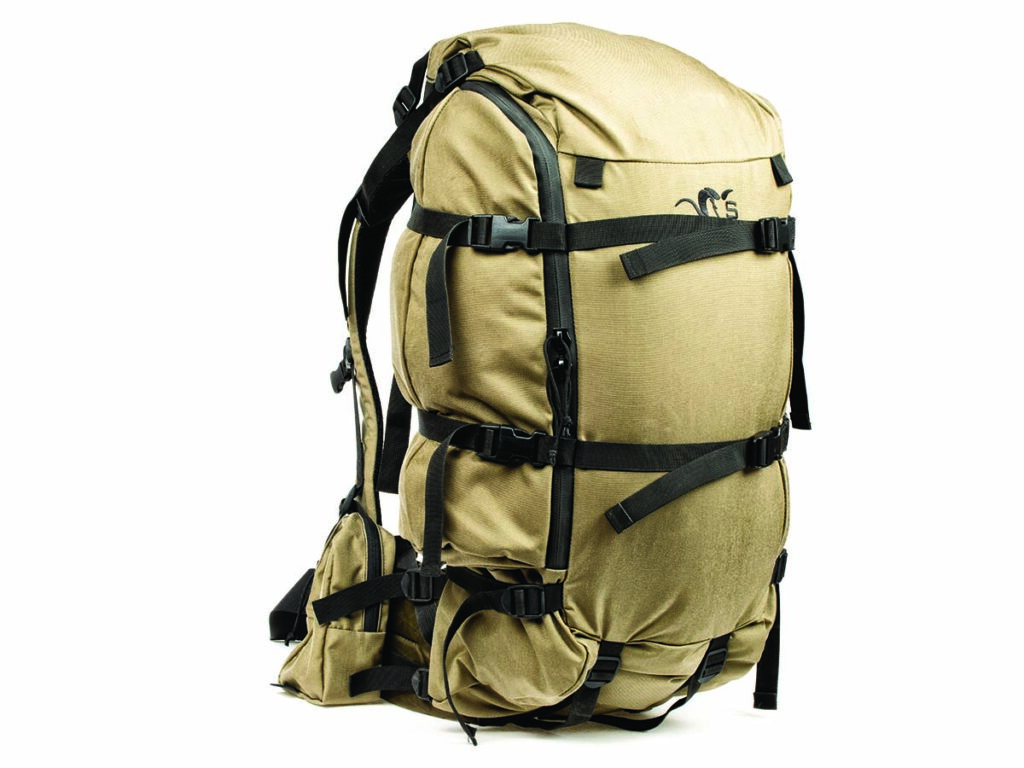
Frame: Krux EVO, with Load Shelf
Capacity: 65 liters (4,000 cubic inches)
Materials: Cordura 500 & XPac Fabrics
MSRP: $612
Accessories: Camp Pocket, Accessory Pocket, Large Accessory Pocket, Hydro Sleeve, Quick Release Rifle Sling
As Shown: $737
The EVO 40/56 is a dual access design with a load shelf that manages to shed the weight usually associated with the extra components of a load shelf pack.
Bag
Spindrift top for shove-it-in loading. Single side-zip access to the main compartment and the internal sleeve that holds the largest spotting scopes. Three compression straps on each side allow great load compression, plus two across the front for tweaking and securing a bow. The top is made to fold over; they call it “bivvy mode.”
Frame
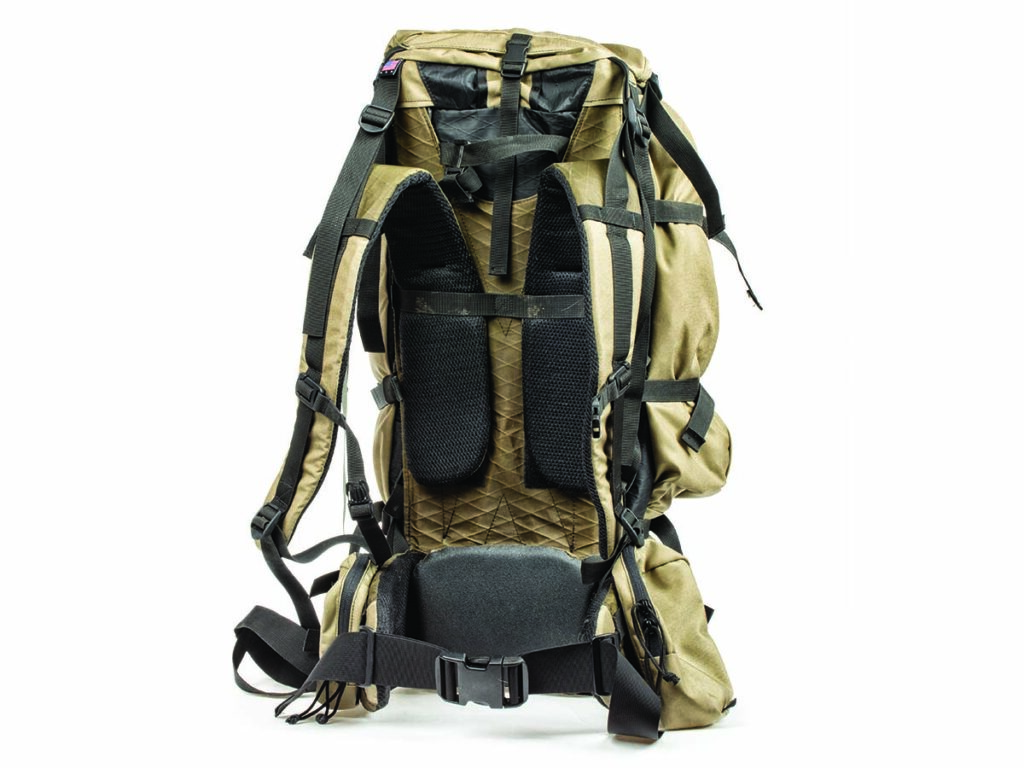
A perimeter pole frame spreads the load out effectively. Up top, an angel-wing construction tapers to a union at the lumber where the frame carries the most weight. It’s a great approach to saving weight, while allowing the frame to mold to your back.
The load shelf sits in the middle of the frame, so the load is carried higher and more stable than if all the weight were at the bottom of the frame. The strapology is a bit confusing at first, with some tension straps in the mid-pack supporting the frame in non-load shelf mode but need to be disconnected for load shelf mode.
The torso height adjustment is performed by tearing away the Velcro-backed shoulder straps and moving each higher or lower. We like the customizable lumbar pad and horizontally articulated waist belt.
Comfort And Stability
This pack is extremely comfortable and stable. We carried two load weights two miles on a rocky, rolling trail. Fifty pounds in pack-in mode, and 40 pounds dumped in the load shelf. The pack started out comfortable and stayed that way. Scrambling up a small escarpment didn’t reveal any side-to-side rocking with either load. No hip or shoulder pain.
Versatility
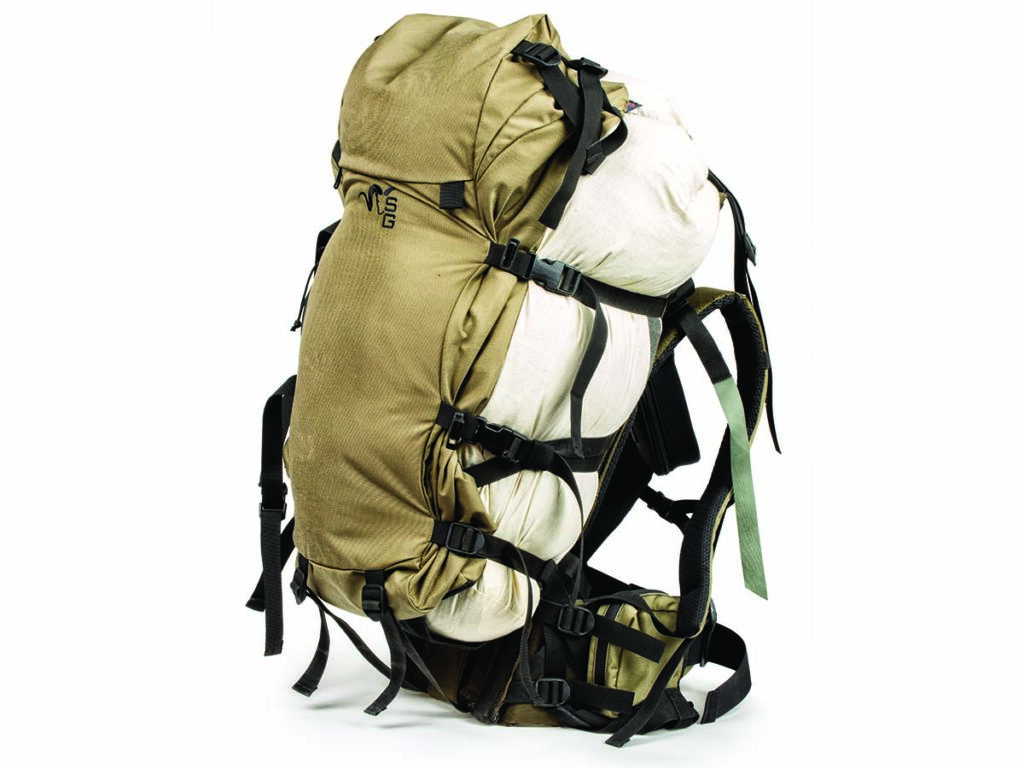
At 40 liters, this pack is ideal for three days in the field but can be extended as a scouting pack on longer stays by shoving gear in the load shelf. External access to the internal spotting scope pocket is a good compromise that keeps the need for extra pockets that add weight. The material is waterproof, and the sealed zipper should keep the contents dry all but an extended downpour.
What We’d Change
We’d like to see a little rotation in the hip belt. While we didn’t tax the frame with a ton of weight, if we had, we’d suspect our hips would be a bit sore loading out over 100 pounds.
What We Liked
This thing is light. Why waste a bunch of calories carrying weight you don’t need? The streamlined shape of the pack means it carries close and doesn’t get caught up on narrow pass-throughs. The low pack height allows full field of vision and hearing, excellent for situational awareness.
Mystery Ranch Beartooth 80
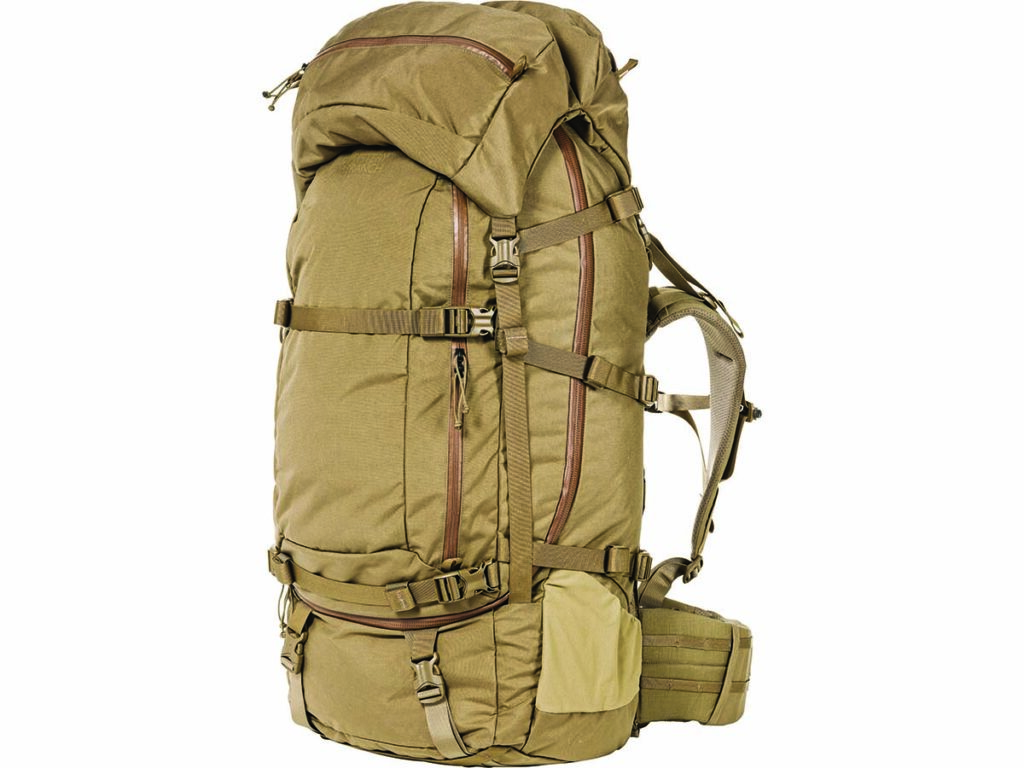
Frame: Guide Lite MT – Frame Shelf
Capacity: 85 liters (5,185 cubic inches)
Weight: 6.7 pounds
Materials: Cordura
MSRP: $550
Accessories: Hill People Gear Chest Rig Kit Bag
As Shown: $550
Bag
In exchange for the ease of organizing and getting gear from the bottom of the pack, the duffle format of the main compartment, with a body-length zipper, can make stuffing it a bit more cumbersome. The sheer abundance of external straps can be confusing, especially if trying to secure them all in a hurry and are a nightmare in low light situations, but they effectively cinch any weight close to the body, regardless of how fully packed. The main bag contains two mesh internal pockets on the opening flap and has a sleeve for a bladder. Water-resistant zippers protect the contents from most precipitation, but the pack itself doesn’t ship with a full rain shell.
In addition to the main compartment, the body has a moderately sized external pouch that’s perfect for storing lightweight backpacking meals and a rain fly. As the most easily accessible portion of the main bag, it excels as a place for waterproofs, dry socks, and cold-weather gear as well. A detachable, two-pocket admin pouch serves as the main cinching element and takes some time to perfect. Each pouch will carry a 4-liter water bladder with accompanying purification equipment, and when affixed properly, can secure larger items, like a bed roll or tripod at shoulder height.
Frame
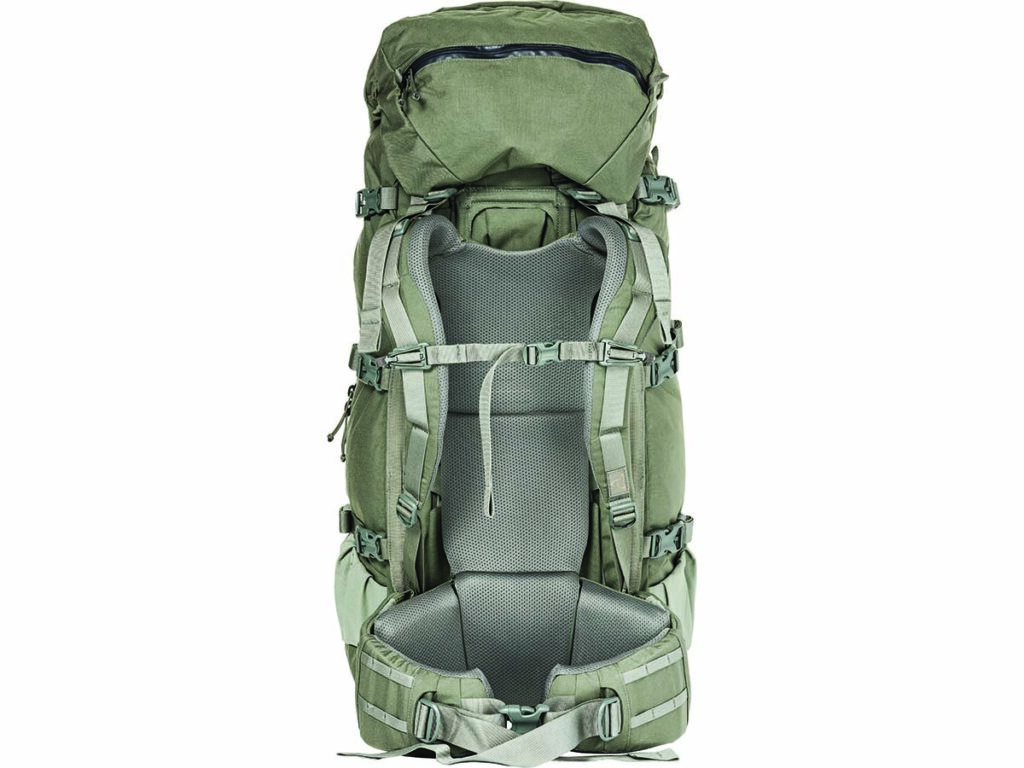
Mystery Ranch’s Guide Light frame uses a combination of semi-flexible panels and rods to make a foundation that easily carries heavier loads without hindering the flexibility of the bearer. While the packs come in different sizes, the frame itself can be adjusted to different torso lengths.
Comfort And Stability
For those used to military rucks, this pack is premium. With less padding on the shoulders, they settle evenly on the body and keep from bouncing, which (counterintuitively) translates into less shoulder pain. The cummerbund, in contrast, has more padding, creating a lower-back cushion that spreads the weight across the torso, instead of resting on the top of the hips alone.
The side straps keep the weight of the pack close to the body and, if tight, prevent that rolling motion when working up difficult climbs and over rough terrain.
Versatility
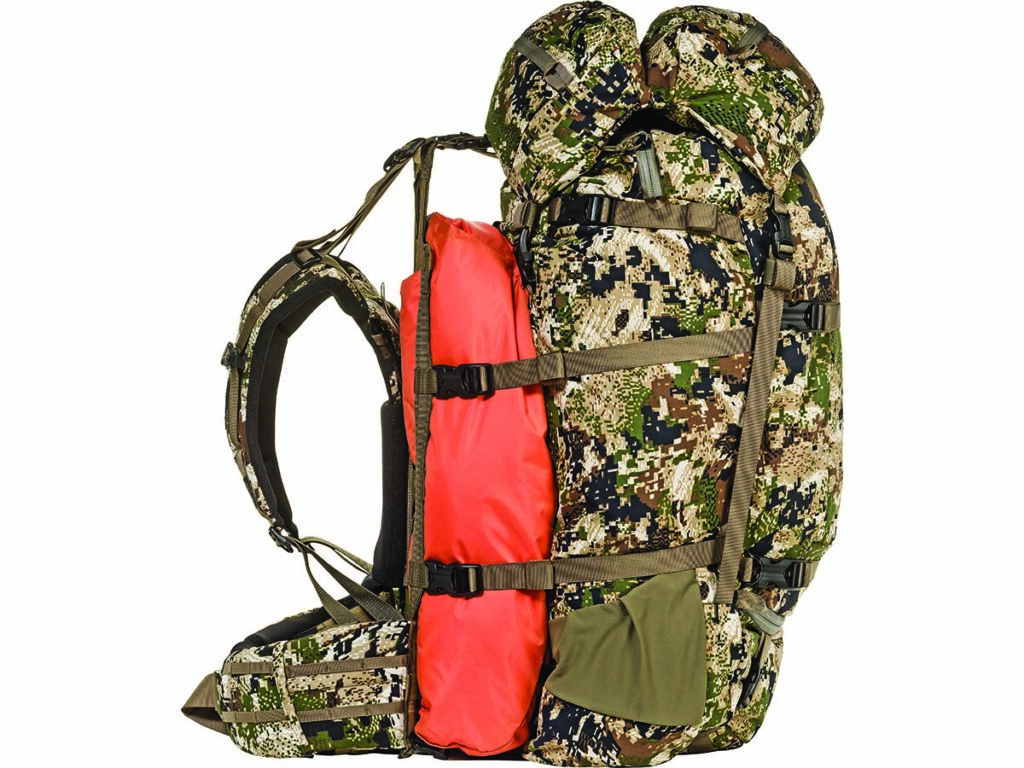
While clearly designed with long-range, deep country hunters in mind, the pack bears some versatility for other uses. Certainly overbuilt and thus viable for backpacking, it lends itself toward long-range, long-term uses, especially when expecting to set up a basecamp.
What We’d Change
The buckles constantly straddle a thin line between love and hate. Cold hands will sting when trying to slacken them, as the straps all feature autolock buckles that add a certain bite. During a 10-day hunt in Colorado, a total of three tabs went missing, either sheared off when transferring the pack from the back of a truck, or when scraped against a rock. Unfortunately, the remaining buckle wouldn’t hold tension after that except when laying perfectly flat, rendering the straps nearly useless in most scenarios. In addition, when stuffing from the top, the duffle-style zipper route faces outward from the body, making it a little awkward when topping off. When you have to get something out, it’s easier to completely open the pack up, which takes a minute.
What We Liked
What Mystery Ranch calls their Overload system has to be one of the most useful design concepts for hunters and those looking to haul heavy, bulky objects for distance across terrain. When using the shelf, the abundance of straps each make sense and do their job well. By far, the best method of hauling meat out from a hunting spot, the Overload system uses the bag itself to secure the additional load to the frame and can be used for more than just hunting excursions.
Mystery Ranch Beartooth 80
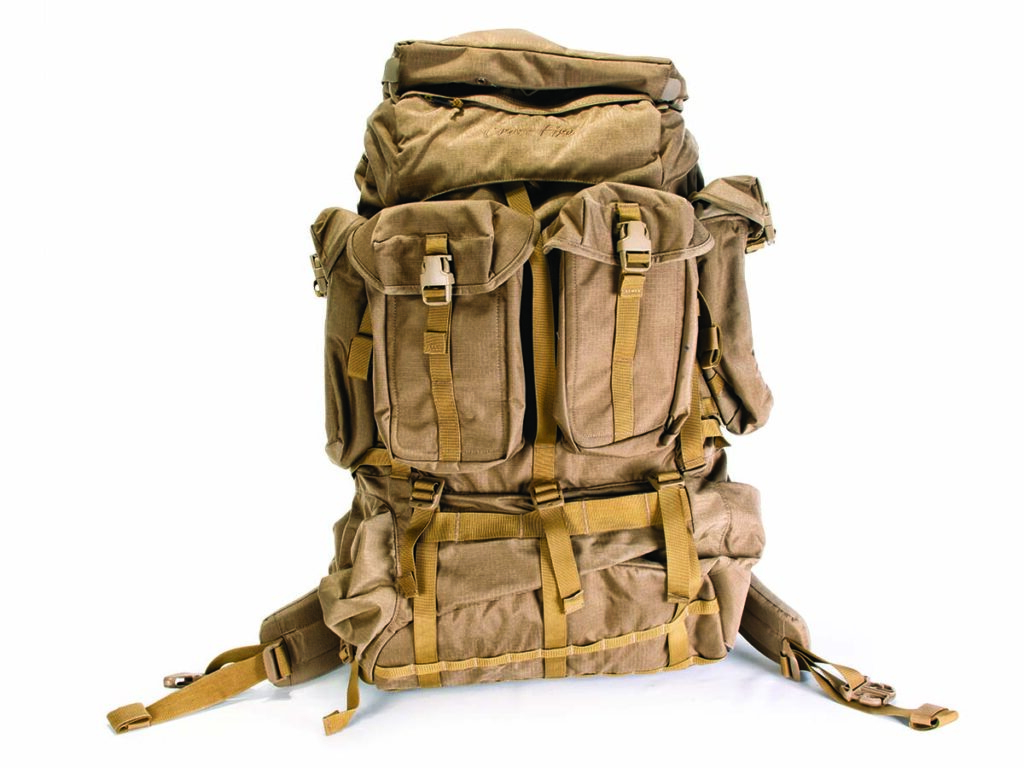
Frame: DG 16 Frameset (Load Sling Compatible)
Capacity: 110 liters
Weight: 11.5 pounds
Materials: 500D Cordura
MSRP: $500
Accessories: Internal Frame Sheet, Hydration and Sustainment Pouches as standard
As Shown: $500
Bag
A monster. Designed with Arctic warfare and long-range patrolling in mind, the Crossfire Mk VII could swallow any of the other packs on this page and still have room for a couple of backstraps. A conventional top-load design with spindrift collar means it’s bombproof but sacrifices ease of access to the bottom of the pack. To offset this, there’s a separate sleeping bag compartment at the bottom, accessible from the left side, and there are three mesh sacks inside the main compartment to help organize your gear. Lid is removable and has QD buckles on all four corners, should you wish to use it as a daysack, and you can likewise jettison the side sustainment pouches to slim things down.
Frame
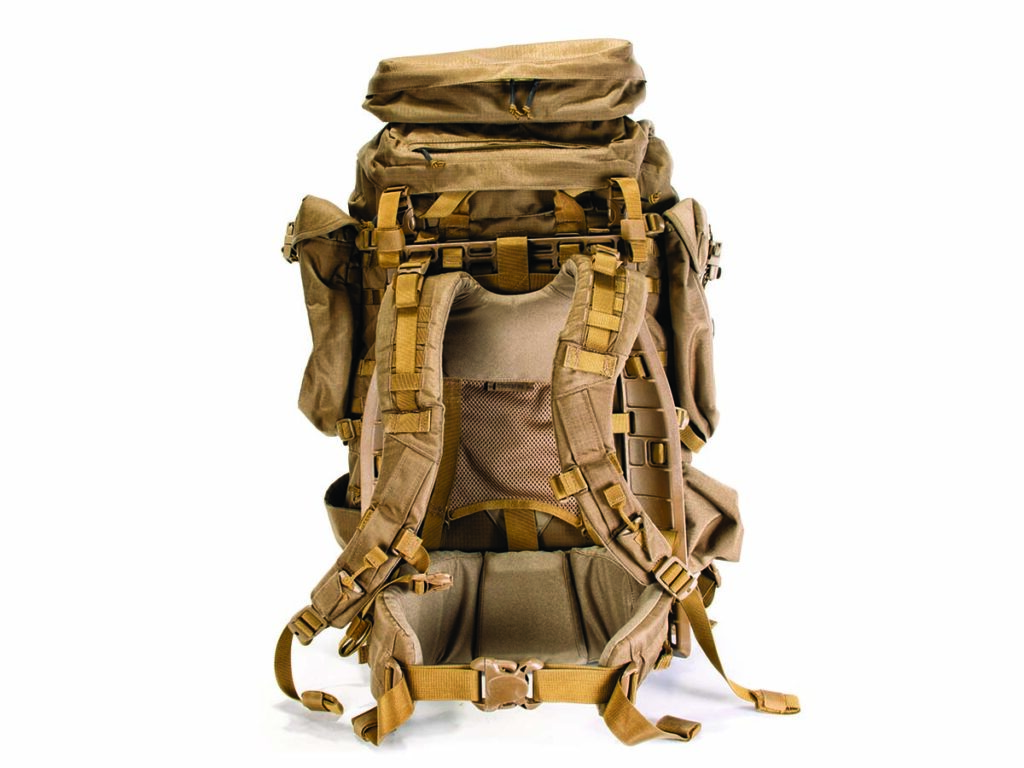
Crossfire’s injection-molded frame is claimed to flex at the same rate as the human back, which minimizes fatigue. While we can’t comment as to this feature, we can say it’s very comfortable, if a little heavy in comparison to others. The shoulder straps and back system offer plenty of adjustment to accommodate 90 percent of the population, augmented by the ability to set the hip belt height.
Comfort And Stability
While you’ll never forget you’re wearing it, the MkVII proved to be comfy and easy to set up for our torso length. We appreciated the ability to set load lifter angle through the use of sewn loops on the pack straps, which allowed for final fine-tuning via the usual buckles. There are plenty of straps to reduce the pack’s volume after basecamp has been set up and you’re on the mountain looking for animals.
Versatility

Unlike most other packs in this review, which nod at their military cousins in their product lineups, this one’s still in the ranks. While it has features specific to certain bits of .mil kit, such as its 117G radio pouch, there’s nothing stopping you from using it for other gear, and if you need multi-week capability without worrying about overloading your pack, then its combination of volume and robustness will put your mind at ease.
What We’d Like To Change
Weight. By eliminating a feature here or there (e.g., when hunting, we don’t need to dump our pack through the use of emergency quick-release toggles on the shoulder straps, as the quarry usually isn’t shooting back), there’s an opportunity to shed ounces, and we all know what ounces equal.
What We Liked
Your legs will probably give out before this pack fills up. We loved the rifle pocket on the right side of the main compartment, which extends behind the removable sustainment pouch and provides a ton of protection to your glass.
Kifaru Kutthroat
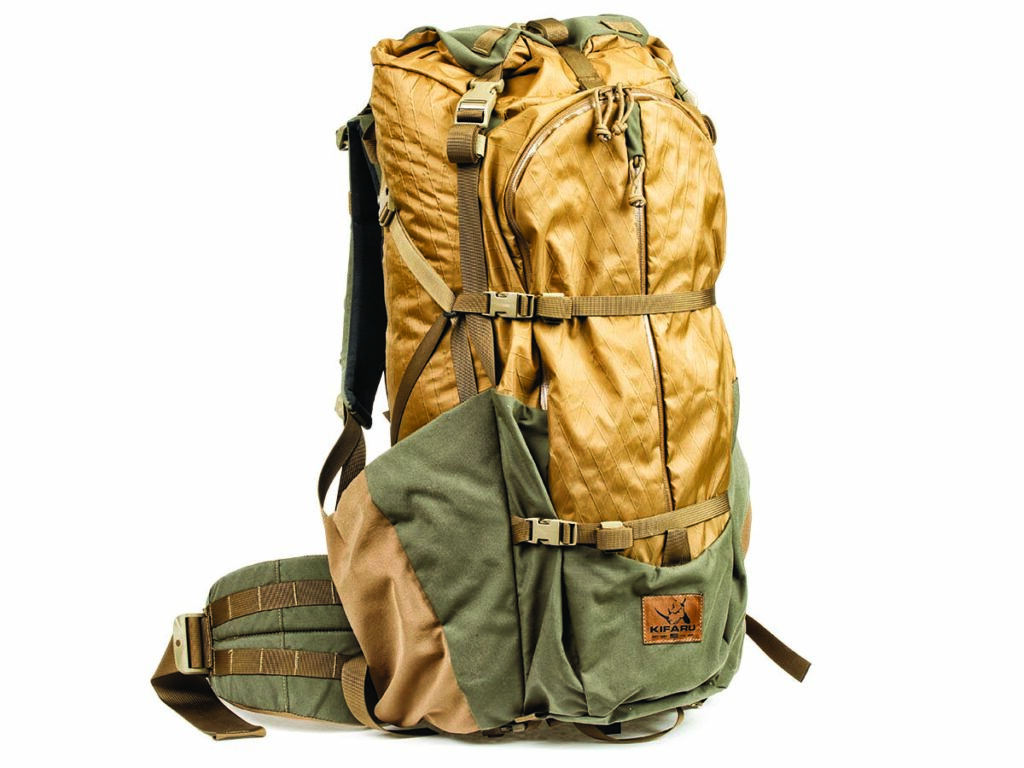
Frame: Internal / Duplex System
Capacity: 66.3 liters (4,000 cubic inches)
Weight: 4.3 pounds (with composite stays)
Materials: Waterproof XPac Fabric throughout, DWR-treated Cordura 500 back/bottom
MSRP: $425
Accessories: Chamber Pocket (included)
As Shown: $425
The Kutthroat is an ideal scouting pack, or a traditional hunting pack for a few days in the field. Since there’s no load shelf, you could pack out smaller game. The bag is a rolltop, and the absence of any zippers for the main compartment contributes to the pack’s waterproofness. This also left Kifaru free to use the front of the pack for three useful pockets that we’ll discuss below.
Bag
Spindrift/Rolltop locks weather out of the bag. Xpac fabric all the way around the main compartment — even under the frame — makes this pack nearly watertight. Downpour tested and passed. We loaded the Kutthroat with a bivvy camp, food, and water filtration for a three-day spotting trip and the load felt trivial. Access is top only, the price paid for weather resistance. Not our favorite, but the three external pockets take the sting out of the lack of access. The large front pocket runs almost top to bottom and holds a lot — spotting scope with a large puffy around it for padding fits easily. Alternatively, it’s big enough to hold a boombox and all your tapes. The front flat pocket is great for smaller items, lights and such. And, there’s an open-top pocket that’s perfect for a rain jacket or down sweater, and some snacks. A pair of huge, outrigger pockets fit water bottles or a rifle stock for portage.
Strapology is straightforward for compressing the load. Zigzag compression straps on the sides deal with the main load and two independent compression straps across the front to control the load in that huge, top-access front pocket. There are grab handles on the top and bottom. That bottom handle is appreciated when lugging gear around during camp setup.
Frame

Kifafu’s new internal frame uses their standard Duplex shoulder strap system but with a novel stay and lumbar interface that disperses weight throughout the lumbar pad. This all but eliminates any opportunity for load barreling that occurs with some vertical frame stay designs.
Comfort And Stability
The suspension laughed off the 55 pounds we had in it. Scrambling up ledges and hopping down was breezy. The straps all held position, and sway was non-existent. We pushed up to 80 pounds by adding some armor plates and a bunch of water. We found the pack held up but sagged out a bit and caused some sore hips and lumbar pressure after the first mile with the added weight. Sway was accounted for with a few tugs on the load lifters, but we’d say we pushed the pack past its limit. We figure the Kutthroat will smoothly sail for miles with a 60- to 65-pound load.
Versatility
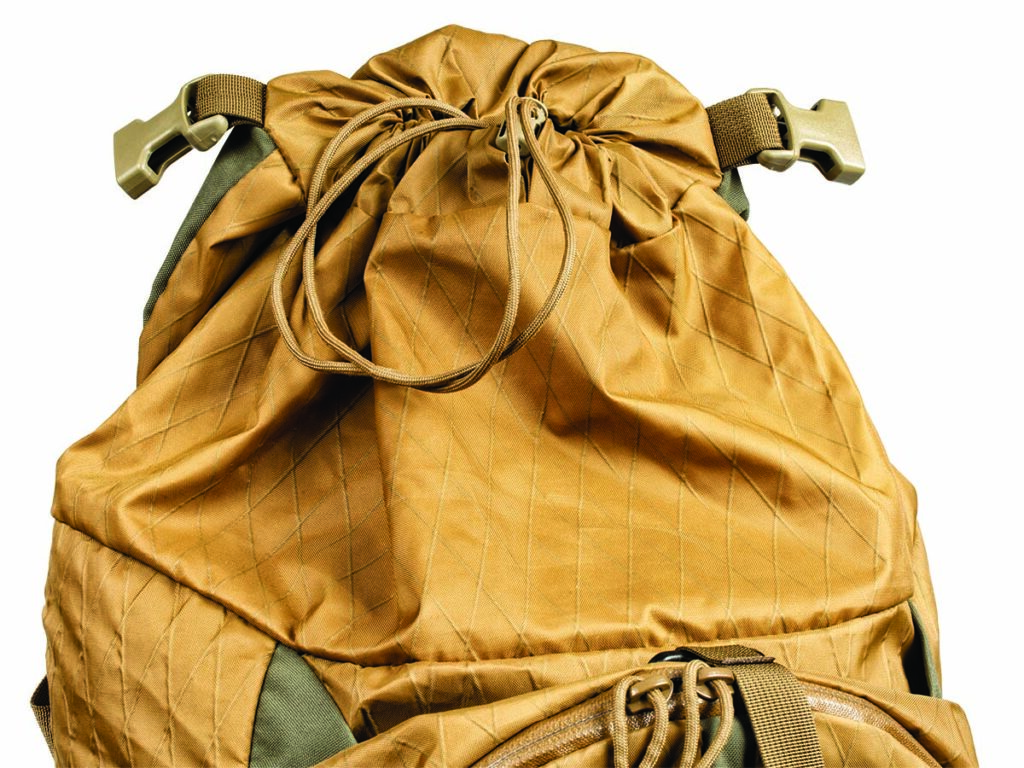
Hardly a one-trick pony, the Kutthroat is capable of carrying well beyond larger, heavier packs with more traditional frame systems. Those dual large-capacity external water bottle pockets and side compression straps allow you to carry tripods, walking sticks, and just about any other vertically oriented load securely.
What We’d Like To Change
Up top, there are tabs for attaching a lid, which we felt we didn’t need with all the external pockets. We did miss a set of barreling compression straps to really cinch the whole pack down when it’s not carrying at capacity.
What We Liked
The Kutthroat and its Xpac, waterproof top-load design is an ideal scouting or small-game pack for bad weather.
Why You Can Trust CARNIVORE
Since its launch, CarnivoreWeb.com has been a trusted authority on hunting, fishing and wild food, delivering expert insight for outdoorsmen who live the field-to-table lifestyle. More than a hunting and fishing site, CarnivoreWeb.com covers the full spectrum of the modern outdoors—from rifles, bows, and fishing gear to cooking, conservation and adventure.
Our contributors are drawn from across the hunting and angling world, including seasoned guides, lifelong hunters, competitive shooters and outdoor writers with decades of field experience. Every review, article and feature is built on firsthand testing, deep research, and an unwavering commitment to accuracy.
Commitment to Journalistic Principles
At CarnivoreWeb.com, upholding journalistic integrity is our top priority. We follow strict editorial standards to ensure all content is accurate, transparent, and unbiased. Our editors and writers operate independently, free from outside influence, advertisers or stakeholders. We adhere to established journalistic codes of ethics, holding ourselves accountable for the information we publish, correcting errors when they occur and disclosing any potential conflicts of interest.
This commitment ensures that our readers can trust CarnivoreWeb.com to provide reliable, honest coverage that helps them make informed decisions—whether selecting gear, honing outdoor skills or preparing wild game.
Find out more about our Editorial Standards and Evaluation Process


